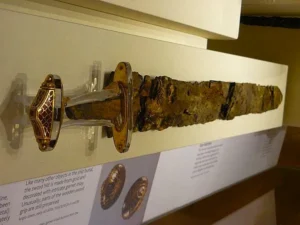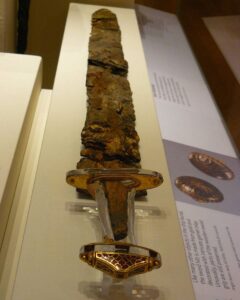An Interdisciplinary Study of the “Living” Sword in Early Medieval Northern Europe

This thesis explores perceptions of two-edged swords as ‘living’ artefacts in Anglo-Saxon England and Scandinavia between c. 500 and 1100. Taking inspiration from recent anthropological and archaeological research into ‘artefact biography’, it considers two interlinked avenues of ‘life’: (1) the notion that swords could acquire life-histories, personalities and other person-like qualities; and (2) the nature of their relationship with warriors (as opposed to other members of society).
The thesis compares Anglo-Saxon England and Scandinavia across a broad chronological period in order to identify how attitudes towards swords developed over time. The almost unique proximity to bloodshed which swords, by contrast with other weapons, provided for their wielders is considered key in fuelling perceptions of swords as ‘living’ artefacts, and strengthening the bond between warrior and weapon. This special connection between swords and violence is interpreted as contributing to the symbolic potency of swords in early medieval Northern Europe.
This thesis adopts an interdisciplinary approach, discussing archaeological, pictorial and written evidence within a carefully-constructed methodological framework. The different sources are integrated in a discussion chapter which attempts to arrive at a holistic understanding of perceptions of ‘living’ swords in early medieval Northern Europe. Finally, the interdisciplinary method deployed in the thesis is assessed, and suggestions for future interdisciplinary research frameworks are made.

Introduction: Swords inspire endless fascination. They are prominent in the mythology and history of many cultures, from King Arthur’s Excalibur in the west, to Japanese Samurai katana in the east, via the weapons described by Islamic philosopher al-Kindi in his ninth-century treatise on sword-making. Despite being long out of general use on the battlefield, swords still fire the imagination. In the past decade, two major UK museums have presented exhibitions about swords – The Noble Art of the Sword: Fashion and Fencing in Renaissance Europe at The Wallace Collection (2012) and Cutting Edge: Japanese Swords in the British Museum at The British Museum (2004-5); while Stirling Council’s decision to lend the Claymore sword popularly associated with Scottish hero William Wallace to a New York exhibition made national news in 2005. Swords also occupy a pivotal role in modern popular culture, be it the fragmentary weapon Narsil in Tolkien’s The Lord of the Rings; the Atlantean sword wielded by Robert E. Howard’s fantasy hero Conan; the sword Green Destiny which fuels the plot of Ang Lee’s Oscar-winning Crouching Tiger, Hidden Dragon; or The Bride’s quest to obtain a katana forged by legendary sword-smith Hattori Hanzō in Quentin Tarantino’s Kill Bill film series.

Such fascination is not solely attributable to the morbid appeal inherently associated with instruments of death. To take the best-known example, the symbolic power of swords is widely acknowledged to be part of Japanese culture, but in early medieval northern Europe they are primarily read as status symbols, despite many signals from contemporary art, literature and material culture that they were far more than this. To date, perceptions of swords and their significance in early medieval society have not been subjected to a dedicated study. Certainly the picture is beginning to broaden, thanks to research into ‘artefact biography’ which offers new ways of approaching objects and interpreting their significance to human beings. Fresh views of early medieval swords are now highly relevant following the discovery of the Staffordshire Hoard in 2009. This unprecedented assemblage of Anglo-Saxon metalwork, uniquely dominated by sword fittings, has placed these weapons back upon the research agenda. Therefore, the time is right and the methodological tools in place to revisit early medieval swords from a new perspective, which looks